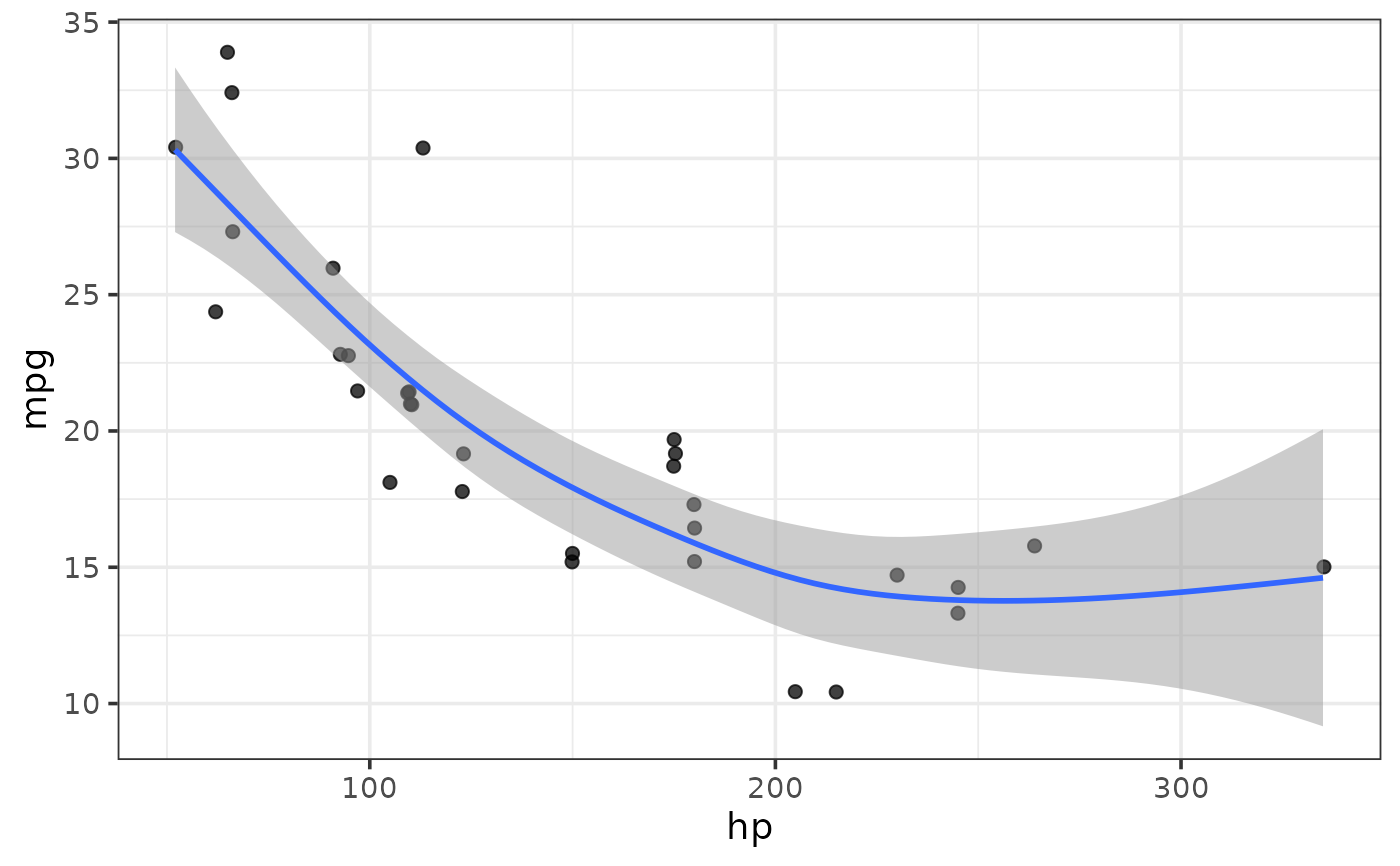Easily generate a ggplot2 graph using a class-appropriate
geometry for the chosen primary (required) and secondary (optional)
variable(s) from the same data frame source using other elucidate plot_*
functions with a restricted set of customization options and some modified
defaults. See "Arguments" section for details and
this
blog post for an introduction to ggplot2. To obtain plots of all
variables/columns of a data frame, use plot_var_all or
plot_var_pairs instead.
plot_var(
data,
var1 = NULL,
var2 = NULL,
group_var = NULL,
var1_lab = ggplot2::waiver(),
var2_lab = ggplot2::waiver(),
title = ggplot2::waiver(),
caption = ggplot2::waiver(),
fill = "blue2",
colour = "black",
palette = c("plasma", "C", "magma", "A", "inferno", "B", "viridis", "D", "cividis",
"E"),
palette_direction = c("d2l", "l2d"),
palette_begin = 0,
palette_end = 0.8,
alpha = 0.75,
greyscale = FALSE,
line_size = 1,
theme = c("bw", "classic", "grey", "light", "dark", "minimal"),
text_size = 14,
font = c("sans", "serif", "mono"),
legend_position = c("right", "left", "top", "bottom"),
omit_legend = FALSE,
dnorm = TRUE,
violin = TRUE,
var1_log10 = FALSE,
var2_log10 = FALSE,
point_size = 2,
point_shape = c("circle", "square", "diamond", "triangle up", "triangle down"),
regression_line = TRUE,
regression_method = c("gam", "loess", "lm"),
regression_se = TRUE,
bar_position = c("dodge", "fill", "stack"),
bar_width = 0.9,
basic = FALSE,
interactive = FALSE,
verbose = FALSE
)Arguments
- data
Either a data frame containing variables to be plotted or a vector to be plotted (unlike most other
plot_*functions, which always require a data frame). Note that if a vector is supplied here, argumentsvar1,var2, and/orgroup_varcannot also be used.- var1
The name of the primary variable you want plot(s) for (quoted or unquoted), e.g. var1 = "variable" or var1 = variable. If a data frame is supplied to the
dataargument, thenvar1must also be specified.var1will be assigned to the x-axis ifvar2is not specified. Ifvar2is also specified,var1will be assigned to the y-axis if it is a numeric, integer, or date variable or to the x-axis if it is a factor, character, or logical variable.- var2
The name of a secondary variable to plot against the primary variable (quoted or unquoted), e.g. var2 = "variable" or var2 = variable.
var2is usually assigned to the x-axis. However, ifvar1is a categorical (factor, character, or logical) variable andvar2is a numeric, integer, or date variable,var2will be assigned to the y-axis andvar1will be assigned to the x-axis. Ifvar1andvar2are both categorical variables,var1will be assigned to the x-axis andvar2will be assigned tofacet_var.- group_var
Use if you want to assign a grouping variable to fill (colour) and/or (outline) colour e.g. group_var = "grouping_variable" or group_var = grouping_variable. Whether the grouping variable is mapped to fill, colour, or both will depend upon which
plot_*function is used (See "Value" section). For density plots, both fill and colour are used for consistency across the main density plots and added normal density curve lines (if dnorm = TRUE). For bar graphs and box-and-whisker plots, the variable will be assigned to fill. For scatter plots, the variable will be assigned to colour. Seeaesfor details.- var1_lab
Accepts a character string to use to change the axis label for the variable assigned to
var1.- var2_lab
Accepts a character string to use to change the axis label for the variable assigned to
var2. Ignored ifvar1andvar2are both categorical variables (sincevar2will be used for faceting in such cases).- title
A character string to add as a title at the top of the graph.
- caption
Add a figure caption to the bottom of the plot using a character string.
- fill
Fill colour to use for density plots, bar graphs, and box plots. Ignored if a variable that has been assigned to
group_varis mapped on tofill_var(seegroup_varargument information above). Default is "blue2". Usecolour_optionsto see colour option examples.- colour
Outline colour to use for density plots, bar graphs, box plots, and scatter plots. Ignored if a variable that has been assigned to
group_varis mapped on tocolour_var(seegroup_varargument information above). Default is "black". Usecolour_optionsto see colour option examples.- palette
If a variable is assigned to group_var, this determines which viridis colour palette to use. Options include "plasma" or "C" (default), "magma" or "A", "inferno" or "B", "viridis" or "D", and "cividis" or "E". See this link for examples.
- palette_direction
Choose "d2l" for dark to light (default) or "l2d" for light to dark.
- palette_begin
Value between 0 and 1 that determines where along the full range of the chosen colour palette's spectrum to begin sampling colours. See
scale_fill_viridis_dfor details.- palette_end
Value between 0 and 1 that determines where along the full range of the chosen colour palette's spectrum to end sampling colours. See
scale_fill_viridis_dfor details.- alpha
This adjusts the transparency/opacity of the main geometric objects in the generated plot, with acceptable values ranging from 0 = 100% transparent to 1 = 100% opaque.
- greyscale
Set to TRUE if you want the plot converted to grey scale.
- line_size
Controls the thickness of plotted lines.
- theme
Adjusts the theme using 1 of 6 predefined "complete" theme templates provided by ggplot2. Currently supported options are: "classic", "bw" (the elucidate default), "grey" (the ggplot2 default), "light", "dark", & "minimal". See
theme_bwfor more information.- text_size
This controls the size of all plot text. Default = 14.
- font
This controls the font of all plot text. Default = "sans" (Arial). Other options include "serif" (Times New Roman) and "mono" (Courier New).
- legend_position
This allows you to modify the legend position if a variable is assigned to
group_var. Options include "right" (the default), "left", "top", & "bottom".- omit_legend
Set to TRUE if you want to remove/omit the legend(s). Ignored if
group_varis unspecified.- dnorm
When TRUE (default), this adds a dashed line representing a normal/Gaussian density curve to density plots, which are rendered for plots of single numeric variables. Disabled if
var1is a date vector,var1_log10= TRUE, orbasic= TRUE.- violin
When TRUE (default), this adds violin plot outlines to box plots, which are rendered in cases where a mixture of numeric and categorical variables are assigned to
var1andvar2. Disabled ifbasic= TRUE.- var1_log10
If TRUE, applies a base-10 logarithmic transformation to a numeric variable that has been assigned to
var1. Ignored ifvar1is a categorical variable.- var2_log10
If TRUE, applies a base-10 logarithmic transformation to a numeric variable that has been assigned to
var2. Ignored ifvar2is a categorical variable.- point_size
Controls the size of points used in scatter plots, which are rendered in cases where
var1andvar2are both numeric, integer, or date variables.- point_shape
Point shape to use in scatter plots, which are rendered in cases where
var1andvar2are both numeric, integer, or date variables.- regression_line
If TRUE (the default), adds a regression line to scatter plots, which are rendered in cases where
var1andvar2are both numeric, integer, or date variables. Disabled ifbasic= TRUE.- regression_method
If
regression_line= TRUE, this determines the type of regression line to use. Currently available options are "gam", "loess", and "lm". "gam" is the default, which fits a generalized additive model using a smoothing term for x. This method has a longer run time, but typically provides a better fit to the data than other options and uses an optimization algorithm to determine the optimal wiggliness of the line. If the relationship between y and x is linear, the output will be equivalent to fitting a linear model. "loess" may be preferable to "gam" for small sample sizes. Seestat_smoothandgamfor details.- regression_se
If TRUE (the default), adds a 95% confidence envelope for the regression line. Ignored if
regression_line= FALSE.- bar_position
In bar plots, which are rendered for one or more categorical variables, this determines how bars are arranged relative to one another when a grouping variable is assigned to
group_var. The default, "dodge", usesposition_dodgeto arrange bars side-by-side; "stack" places the bars on top of each other; "fill" also stacks bars but additionally converts y-axis from counts to proportions.- bar_width
In bar plots, which are rendered for one or more categorical variables, this adjusts the width of the bars (default = 0.9).
- basic
This is a shortcut argument that allows you to simultaneously disable the
dnorm,violin, andregression_linearguments to produce a basic version of a density, box, or scatter plot (depending onvar1/var2variable class(es)) without any of those additional layers. Dropping these extra layers may noticeably reduce rendering time and memory utilization, especially for larger sample sizes and/or wheninteractive= TRUE.- interactive
Determines whether a static ggplot object or an interactive html plotly object is returned. See
ggplotlyfor details. Note that in cases where a box plot is generated (for a mix of numeric and categorical variables) and a variable is also assigned togroup_var, activating interactive/plotly mode will cause a spurious warning message about 'layout' objects not having a 'boxmode' attribute to be printed to the console. This is a documented bug with plotly that can be safely ignored, although unfortunately the message cannot currently be suppressed.- verbose
If TRUE, this causes a message to be printed to the console informing you of the classes detected for variables assigned to any of
var1,var2, and/orgroup_varas well as which arguments those variables are passed to in the underlying geom-specific elucidateplot_*function that is used to render the plot.
Value
A ggplot or plotly graph depending on whether static or interactive
output was requested. The type of graph (i.e. ggplot2::geom* layers) that
is rendered will depend upon the classes of the chosen variables, as
follows:
One numeric (classes numeric/integer/date) variable will be graphed with
plot_density.One or two categorical (classes factor/character/logical) variable(s) will be graphed with
plot_bar.Two numeric variables will be graphed with
plot_scatter.A mixture of numeric and categorical variables will be graphed with
plot_box.
References
Wickham, H. (2016). ggplot2: elegant graphics for data analysis. New York, N.Y.: Springer-Verlag.
See also
Examples
data(mtcars) #load the mtcars data
#convert variables "cyl" and "am" to a factors
mtcars$cyl <- as.factor(mtcars$cyl)
mtcars$am <- as.factor(mtcars$am)
# density plot of a single numeric variable on the x-axis
# with normal density curve added as dashed line
#
# normal density curves can be disabled via `dnorm` = FALSE or `basic` = TRUE
plot_var(data = mtcars, var1 = mpg)
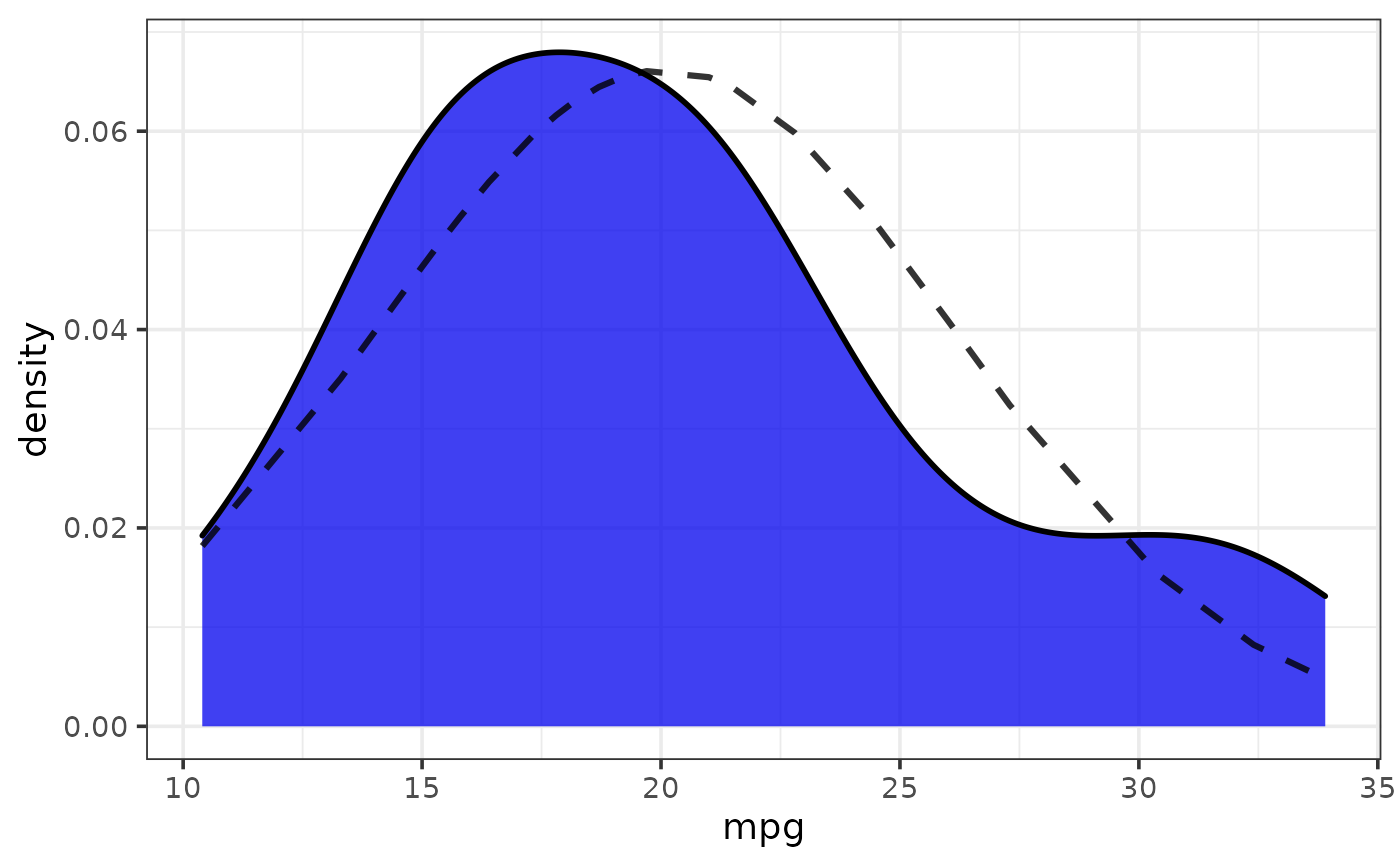 # density plot with a primary numeric variable on the x-axis
# split by a categorical grouping variable assigned to the `fill_var`
# argument of plot_density() & normal density curves distabled
plot_var(mtcars, mpg, group_var = cyl, dnorm = FALSE)
# density plot with a primary numeric variable on the x-axis
# split by a categorical grouping variable assigned to the `fill_var`
# argument of plot_density() & normal density curves distabled
plot_var(mtcars, mpg, group_var = cyl, dnorm = FALSE)
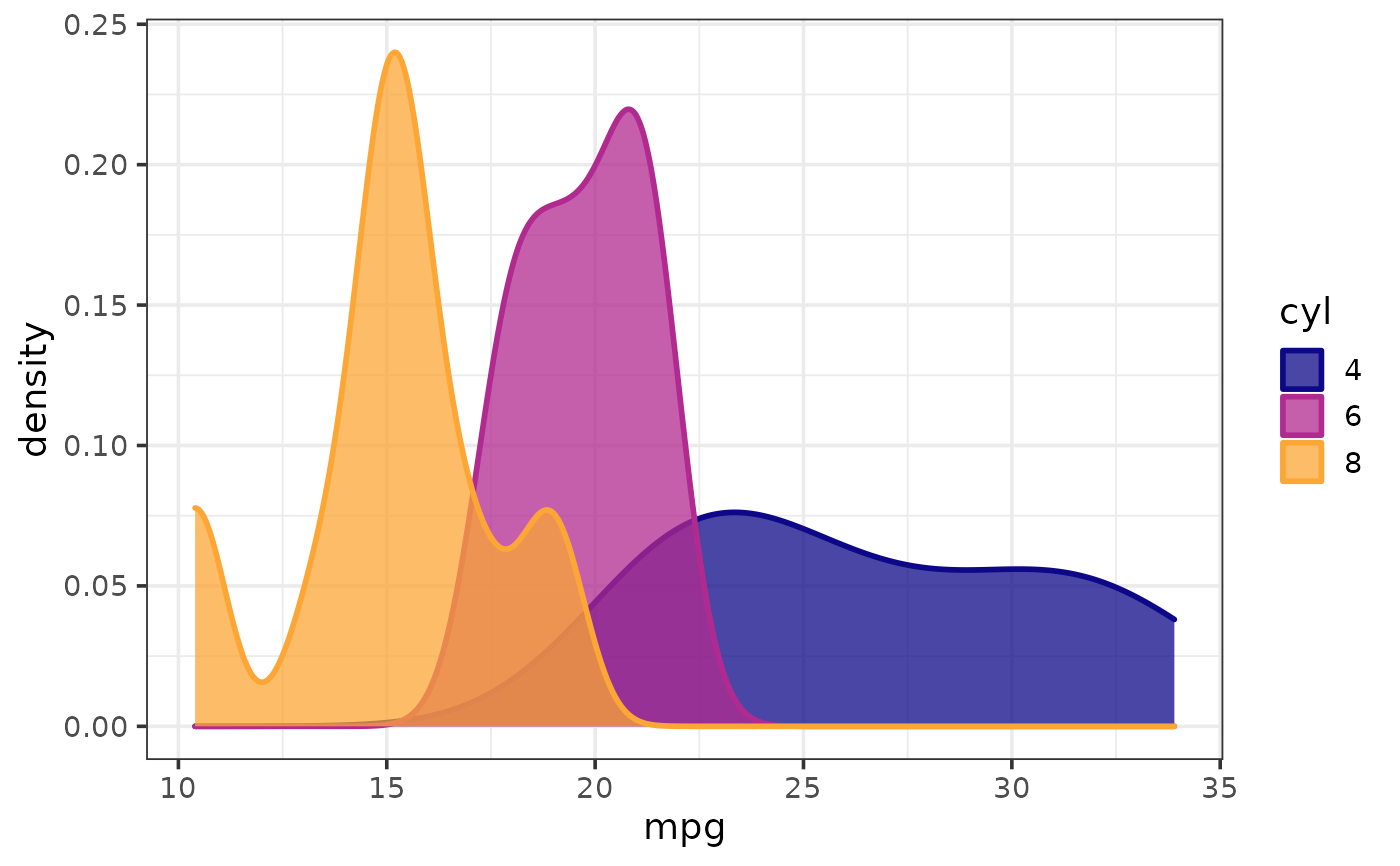 plot_var(mtcars, cyl) #bar plot of a single categorical variable on x-axis
plot_var(mtcars, cyl) #bar plot of a single categorical variable on x-axis
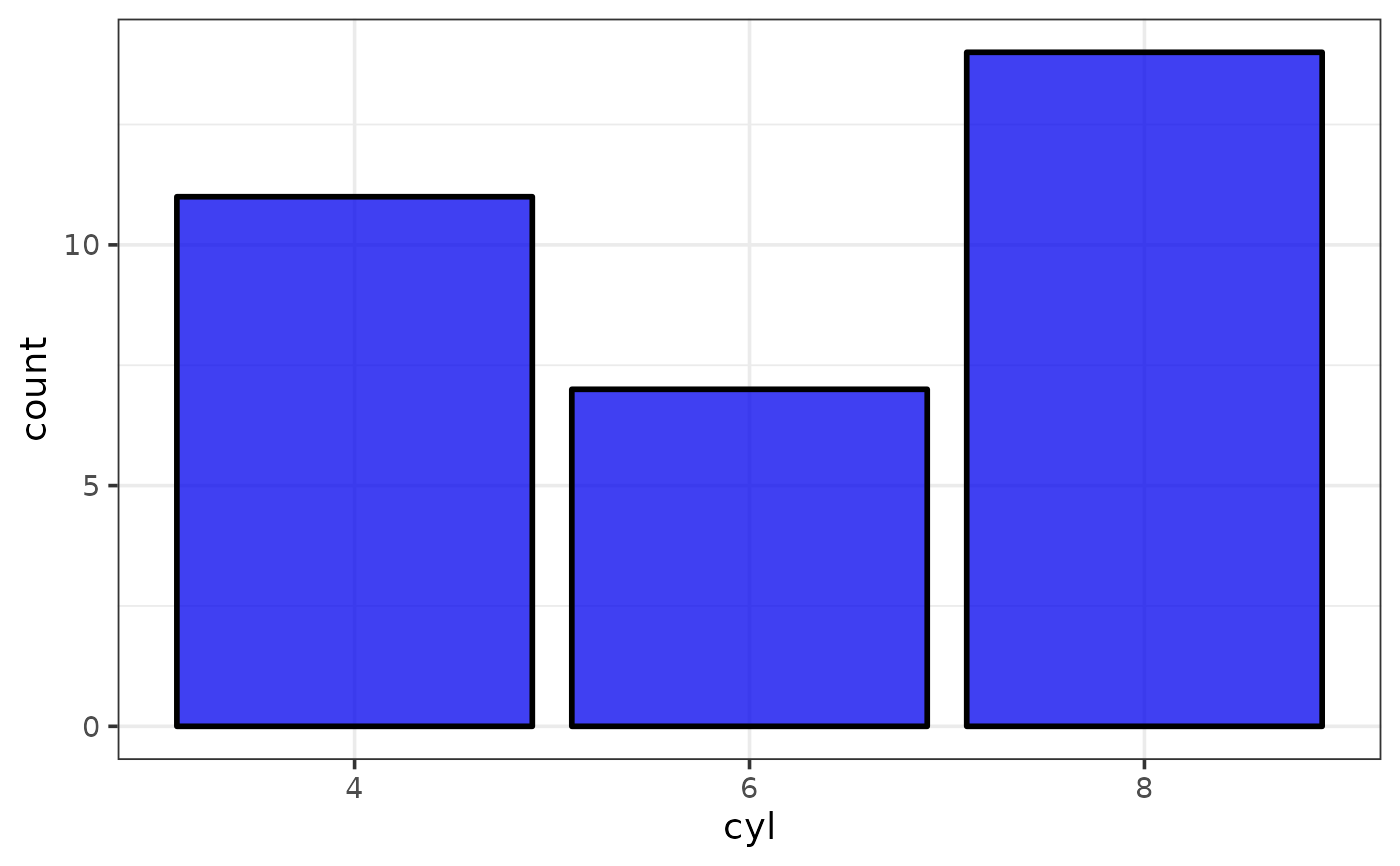 # bar plot with a primary categorical variable on the x-axis and a secondary
# categorical variable used for faceting.
plot_var(mtcars, var1 = cyl, var2 = am)
# bar plot with a primary categorical variable on the x-axis and a secondary
# categorical variable used for faceting.
plot_var(mtcars, var1 = cyl, var2 = am)
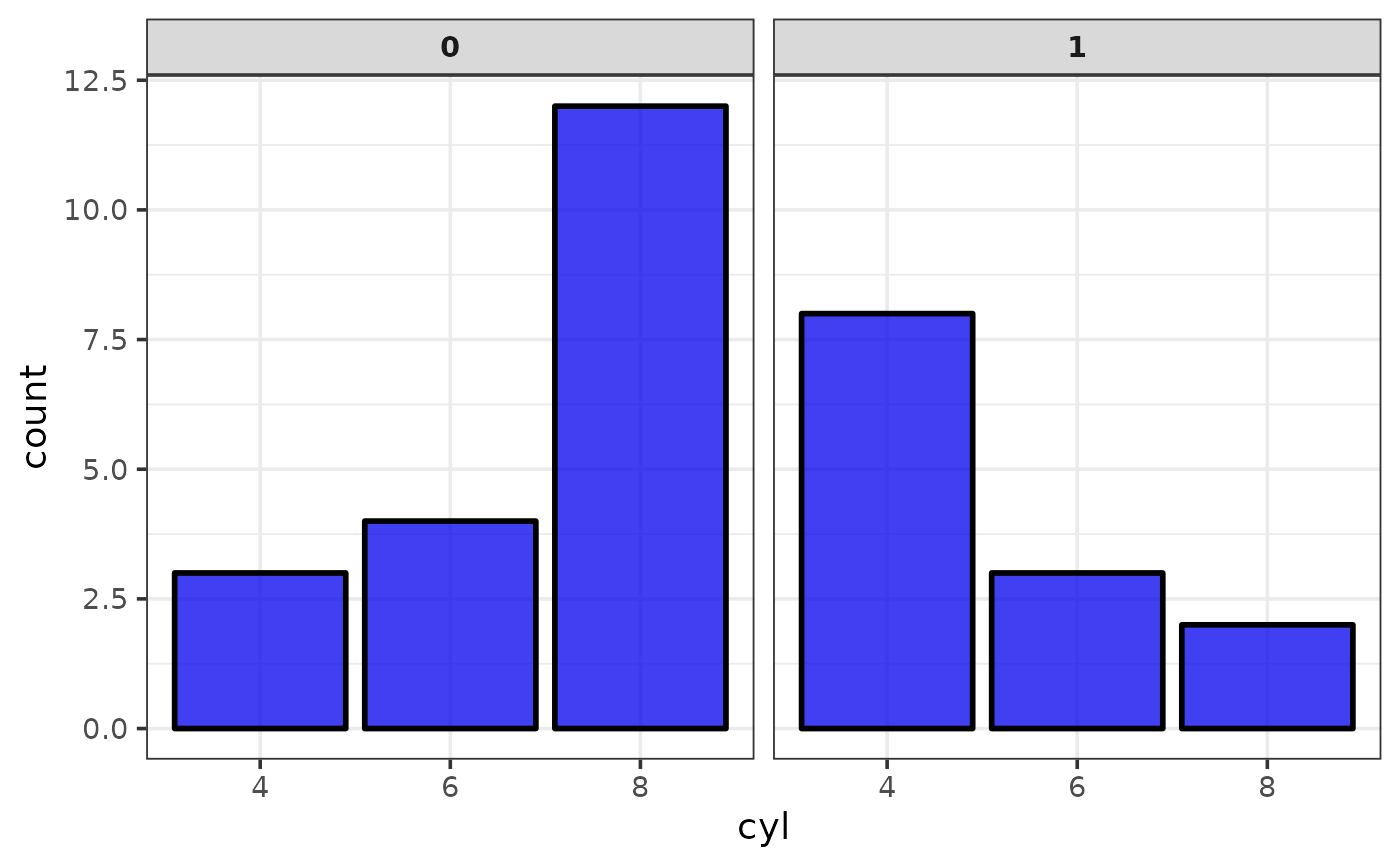 # box plot with added violin plots for a mix of numeric and categorical variables
# and verbose mode enabled to print variable assignment information to the console
#
# the violin plots can be disabled via `violin` = FALSE or `basic` = TRUE
plot_var(mtcars, mpg, cyl, verbose = TRUE)
#> `var1` class = "numeric" and `var2` class = "factor".
#> Building graph with `plot_box()`.
#> Assigning `var1` to `y` and `var2` to `x`.
#> Use `plot_box()` instead to access additional customization options.
#> See help("plot_box") for details.
# box plot with added violin plots for a mix of numeric and categorical variables
# and verbose mode enabled to print variable assignment information to the console
#
# the violin plots can be disabled via `violin` = FALSE or `basic` = TRUE
plot_var(mtcars, mpg, cyl, verbose = TRUE)
#> `var1` class = "numeric" and `var2` class = "factor".
#> Building graph with `plot_box()`.
#> Assigning `var1` to `y` and `var2` to `x`.
#> Use `plot_box()` instead to access additional customization options.
#> See help("plot_box") for details.
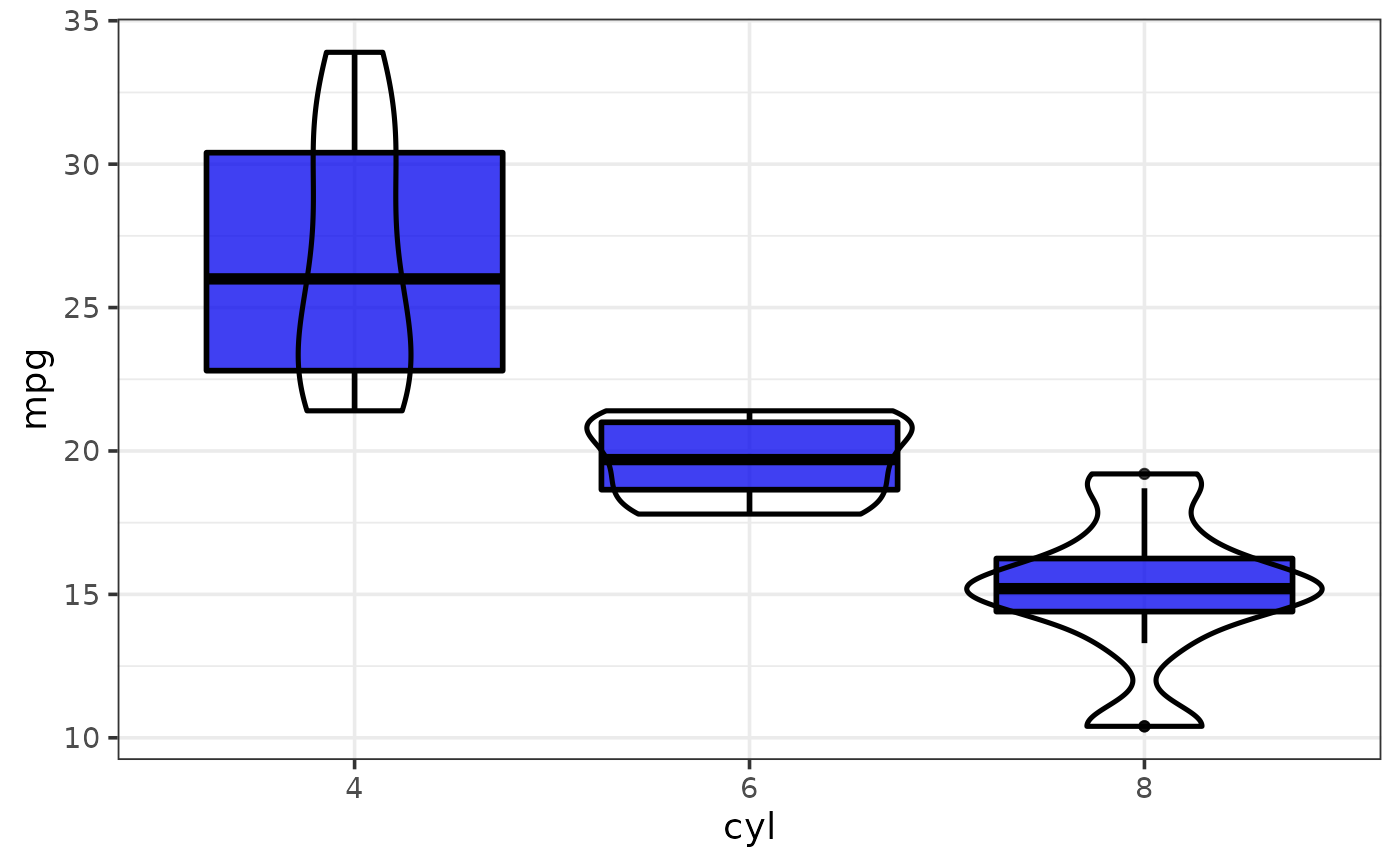 # scatter plot with added generalized additive model regression line and
# 95% confidence envelope for two numeric variables
#
# N.B. the regression line and CI can be disabled via `regression_line` = FALSE or
# `basic`= TRUE
plot_var(mtcars, mpg, hp)
# scatter plot with added generalized additive model regression line and
# 95% confidence envelope for two numeric variables
#
# N.B. the regression line and CI can be disabled via `regression_line` = FALSE or
# `basic`= TRUE
plot_var(mtcars, mpg, hp)
